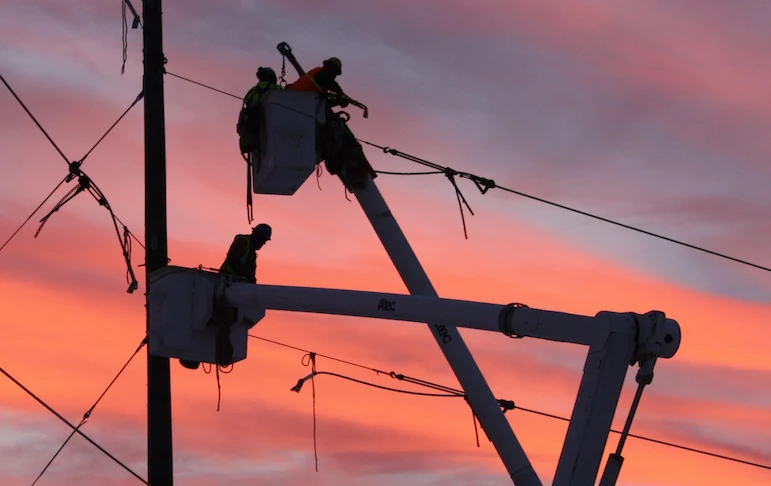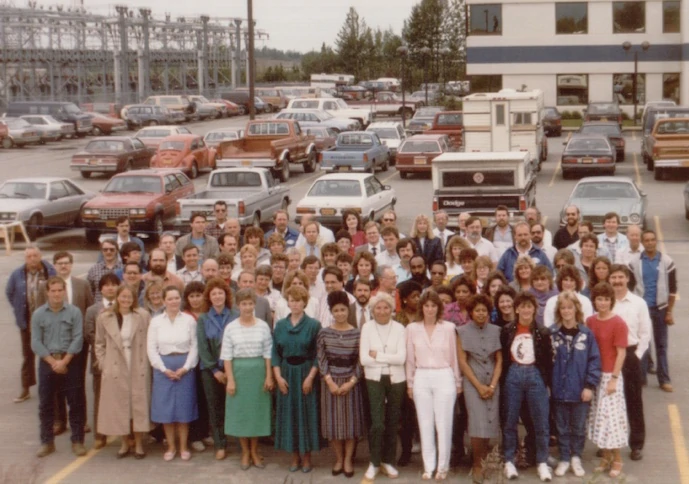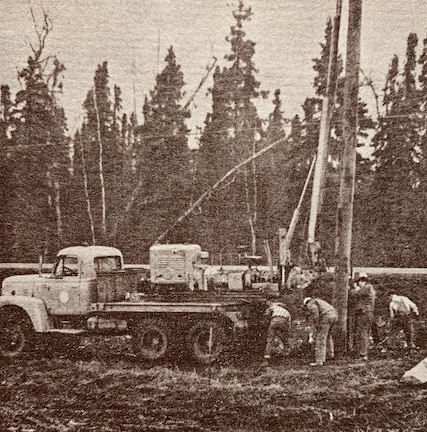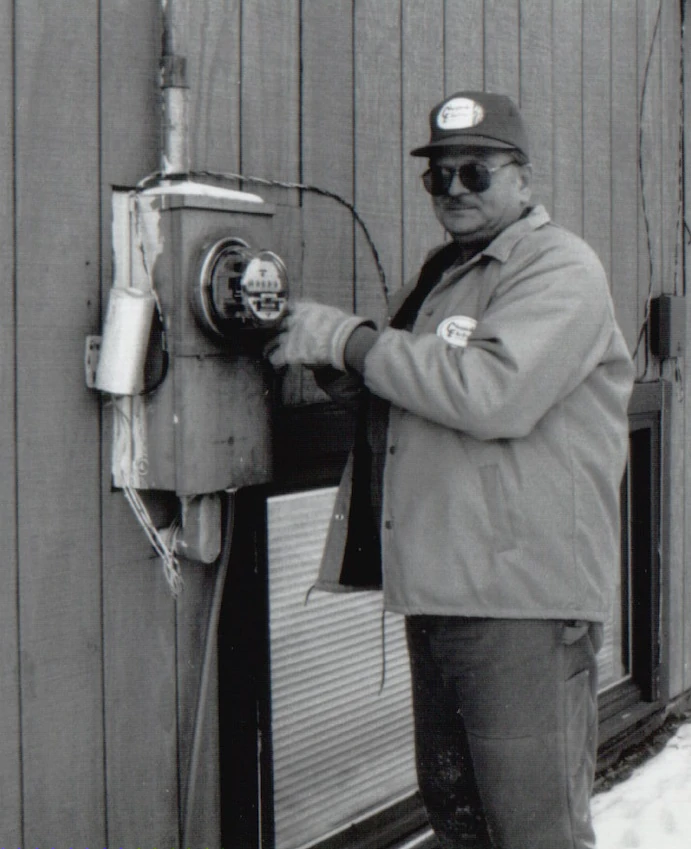Our History
Our History
Anchorage's population boomed during World War II. Among other things, the rapid growth in population strained utility services and the city declined to extend electric service beyond the city limits. In 1947, a group of residents in areas outside the formal city boundaries met to discuss forming an electric cooperative.
Chugach was incorporated in Alaska on March 1, 1948, with funding under the Rural Electrification Act of 1936, as amended. In 1991 Chugach refinanced and paid off its federal debt, leaving the REA program. Today, Chugach remains a cooperative and ranks among the largest of the nearly 900 electric cooperatives nationwide.

Anchorage, 1947: A City of Few Lights
In 1947, Anchorage was a far cry - and countless wolf howls - from the modern city we know today. The population was estimated at less than 20,000 by the Interior Department. Established neighborhoods like Spenard, Rogers Park, Mountain View and Eastchester were considered the boonies.
Life was much different in Anchorage a half century ago. So many things we take for granted today - abundant electricity, natural gas, paved streets and highways, to name a few were non-existent.
In fact, as early as 1941 - as the territory boomed during World War II - electricity became a critical commodity in Anchorage, and was soon in short supply. The existing hydroelectric plants at Eklutna, as well as supplemental diesel generators, were soon taxed far beyond their capacity.
A Critical Need, A Bright Promise
By 1947, the shortage of electricity was so critical the city purchased the stern half of a wrecked ocean-going tanker, the Sackett's Harbor, in a desperate attempt to meet demand. The hulk was beached at the mouth of Ship Creek, and the boilers and generating equipment were used to deliver much-needed power. This makeshift solution was soon generating 42%, nearly half, of Anchorage Public Utilities' power requirement. Unfortunately, the cost was nearly one cent per kilowatt-hour more than the city collected in revenue.
But what Anchorage lacked in amenities and electrical power during the 1940's, it more than made up for with the power of innovation and commitment to the city's future. It was that resolute spirit and strong vision that brought 200 people together in August of 1947 to form a cooperative to bring power to their homes and businesses. That meeting became a promise for the power Anchorage desperately needed to grow and flourish.
Chugach Electric: The Power of Innovation
On March 1, 1948, Chugach Electric was incorporated as an REA (Rural Electrification Administration) cooperative. With $500,000 and a modest debt limit, Chugach set out to create an electrical distribution system to meet the demand and ensure a bright future for Anchorage. Volunteers went door-to-door in those days to collect the $5 membership fee (a fee that has not gone up in more than 50 years!). In August of '48, Chugach opened its first office, paying $25 per month for equipment, rent and utilities. And then, on November 11, as the darkness of winter loomed over the city, Chugach turned on the lights in nine homes in Rogers Park.
From those humble beginnings, Chugach began to grow and expand to keep pace with the region's burgeoning expansion. The hallmarks of the area's growth were everywhere. Anchorage International Airport was nearing completion. A paved road between Anchorage and the Matanuska Valley was planned. A road to link the Kenai Peninsula and Anchorage was commenced. And the new, 400-room, $6 million Native Hospital was underway.



In just four short years, Chugach went from nine member customers to more than 5,300. From makeshift, unreliable sources of electrical supply in 1948 to the modern 9,500 kilowatt Knik Arm power plant in 1952, Chugach energized south central Alaska with power to spare. In the years leading up to statehood in 1959, Chugach delivered the energy for growth, forging new partnerships and expanding generation and distribution capabilities.
1953: Chugach begins selling power to the Matanuska Electric Association to meet growing demand for electricity in the Mat-Su Valley.
1954: Chugach opens new offices at 8th and Gambell in Anchorage. Chugach continues to extend power lines to connect new customers throughout the Anchorage Bowl, from Mountain View to the Turnagain area. Chugach spearheads an initiative by the Central Alaska Power Association to build a hydroelectric power plant at Cooper Lake. Chugach purchases Inlet Power and Light Company, adding 1,442 customers to its 7,500 strong membership.
1955: The Cooper Lake power plant application is approved by the Federal Power Commission. The Eklutna power plant comes on-line with two 15-megawatt generators to serve Anchorage and the Mat-Su Valley. Chugach begins planning for a 50-mile service line to extend service to the Portage area.
1957: Chugach opens a modern appliance store in Anchorage to help serve its customers with the latest electrical appliances and affordable 4% financing. Chugach offers to assume management of the Alaska Railroad's Knik Arm power plant.
1958: Chugach energizes the first section of the new Portage power line. Meanwhile, expansion of the steam capacity at the Knik Arm power plant increases output from 9.5 megawatts to 14.5 megawatts. Negotiations are finalized with the railroad; Chugach assumes management and operation of the Knik Arm plant.
1959: As a member of ARECA (Alaska Rural Electric Cooperative Association), Chugach lends its support to the Bradley Lake hydroelectric project. Chugach assumes management of the Cooper Lake power plant. Homer Electric agrees to purchase power from Chugach's Cooper Lake project.
The early 60's:A Whole New Level of Energy
In 1960, Anchorage's population had reached 82,833. In just 12 short years, Chugach member ranks had swelled from the original nine households to more than 12,500 homes and businesses, and the days of uncertain electrical power were all but forgotten. The Cooper Lake power plant came on-line, and Chugach began to look at gas-fired power generation when oil and gas is discovered off the Kenai Peninsula.
1961: L.J. "Bud" Shultz was hired as General Manager of Chugach, a position he would hold for the next two decades. His previous experience with an outside electrical cooperative brings new ideas and valuable experience for Chugach's growth and expansion. Chugach plays a key role in the formation of The Central Alaska Power Pool, formed to provide power planning for Southcentral Alaska. Chugach begins construction of a 40-mile distribution line to provide power to consumers in Moose Pass, Cooper Landing and the surrounding Kenai Lake area. 1962: With the completion of the transmission line between the Kenai Peninsula and Anchorage, power flows from Cooper Lake to Anchorage for the first time. Standard of California discovers the Beluga River gas field.
1963: Chugach dedicates the 7.8-megawatt gas turbine Bernice Lake power plant. A contract is signed to furnish power to Homer Electric.
1964: Rock and Roll Comes to Alaska
At 5:36 p.m. on March 27, an earthquake measuring a whopping 8.6 on the Richter scale rocked Southcentral Alaska with devastating violence. Chugach generation and distribution facilities were hit hard. As ground levels heaved and shifted dramatically, the entire Anchorage area lost power. Generators were knocked offline, and transmission lines snapped in the wake of the quake.
Emergency crews scrambled to assess damage, make repairs and restore power as quickly as possible. Within 24 hours Chugach restored operation of a single generator at the Knik Arm plant, and with the help of the military and the city, power is restored to much of the city.
It took weeks of round-the-clock effort to repair much of the damage. But just a few short months following the quake, Chugach was once again looking ahead and charting new directions for growth and expansion. In 1964, just months after the most devastating earthquake in North America's modern history, Chugach began negotiating long-term natural gas contracts at Beluga. Clean-burning, economical and efficient, natural gas was fast becoming the fuel of choice at Chugach. Meanwhile, Chugach completed the first unit at its International Airport Road power plant, a 15-megawatt unit that could run off natural gas or oil. That same year, Chugach was chosen to supply electricity to Whittier, a town particularly hard-hit during the earthquake.
1965: The population of Anchorage tops 102,000. Chugach adds a second 15- megawatt unit at the International plant, and begins construction of the Beluga plant along with transmission lines to Anchorage. Tyonek is added to Chugach's service area.
1967: Chugach converted Knik Arm's coal boilers to natural gas. Underwater cables were laid in Cook Inlet to carry power between Pt. MacKenzie and Pt. Woronzof in Anchorage. Hope (in more ways than one) was added to the Chugach system in November of 1967.
1968: Chugach ushers in a new era of electrical power for Anchorage and many customers throughout the Railbelt area. In March of 1968, the first power from two 15.7-megawatt units at Chugach's modern, new gas-fired power plant at Beluga flowed into Anchorage. A third 18.5-megawatt unit is added to the International plant in 1969 in anticipation of the region's growing energy demands.
The 70's: More Bang for the Boom
1970-75: Throughout the 70's, Chugach continued to meet and anticipate - Alaska's extraordinary growth. Generation, transmission and distribution systems were expanded and upgraded to keep pace with the rising population. A second 19- megawatt gas-fired turbine was added at Bernice Lake in 1971, and a second set of underwater cables added between Pt. MacKenzie and Woronzof. In 1972, the largest turbine at the time, a 55-megawatt gas-fired unit was installed at Beluga. With the discovery of oil on the North Slope, Southcentral Alaska boomed as never before. With Anchorage's population at 177,817 and growing daily, two additional generation units were added at Beluga giving the plant an additional 140 megawatts capacity.
1976: Chugach added four new underwater cables between Pt. MacKenzie and Woronzof.
1978: Chugach added two more gas turbines to its system: a 74-megawatt unit at Beluga and a 27.5-megawatt unit at Bernice Lake.
The 80's: A Decade of Confidence, Creativity and Commitment
The 1980's saw Anchorage's population bulge to nearly a quarter million residents at the height of the oil boom. And then, fueled in part by a drop in worldwide oil prices, the latter half of the decade plunged Southcentral Alaska into a deep recession. Chugach hustled in the early 80's to satisfy the region's growing energy demands, and then - seemingly overnight - faced a recession that saw the first decline in power sales in its 32-year history. With thoughtful belt-tightening and aggressive management, Chugach weathered the recession and continued to expand and upgrade capacity and service.
1980: Chugach installed its eighth and final unit at Beluga, a 55-megawatt unit that created "free" electricity by running on steam generated by two other units. Beluga's capacity was now rated at an impressive 365 megawatts.
1981: Chugach installed a fourth unit at Bernice Lake, a 27.5-megawatt unit that brought the plant's capacity to 81.8 megawatts.
1983: Following several years of serious revenue deficits, Chugach rebounded owing in part to a long overdue rate increase instituted the previous year.
1984: Chugach moves its headquarters to its present location, a new building beside the International power plant.
1985: Chugach completed construction and implementation of the SCADA (Supervisory Control and Data Acquisition) project. The system uses a sophisticated telecommunications network to link Chugach's far-flung transmission system with computers and a huge display board located at the Central Dispatch Center. Chugach power dispatchers can now monitor and troubleshoot generation, transmission and distribution problems from Chugach headquarters. Also in 1985, power began flowing from Anchorage over the new intertie completed by the Alaska Power Authority linking Anchorage and Fairbanks.
1986: Following nearly four decades of growth and expansion, 1986 marked the beginning of a years-long recession that would test Chugach's stamina, strength and resourcefulness.
1987-88: Chugach began intensive systemwide maintenance of turbines and generators, including the overhaul of units at Bernice Lake, Cooper Lake and Beluga.

